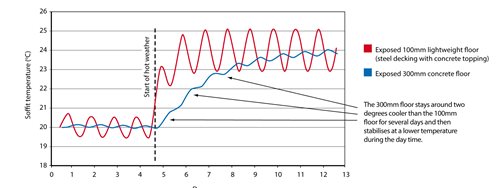Is 100mm of concrete enough in naturally-ventilated buildings?
A question sometimes asked by architects and designers is: "Will 100mm of concrete provide enough thermal mass?" The answer largely depends on the extent to which you want to optimise the building design. It may be thought that a 100mm of concrete is sufficient, but depths in excess of 100mm can often provide a further benefit when you consider how buildings actually respond to real weather conditions.
For example, a naturally-ventilated office with exposed 100mm concrete composite floors (steel decking/soffit with insitu concrete topping) might have sufficient heat capacity to cope with a simple 24-hour heating and cooling cycle. However, in addition to a building’s daily cycle, there are also longer cycles related to a typical hot spell (usually three to five days) and also the five working days per week cycle, from which heat will reach different depths within the available thermal mass.
In the case of floors in a non-air conditioned building for example, the greater the slab depth, the longer the time period it responds to; the core of a 300mm thick concrete slab responds to the monthly average condition and draws heat in deeper over an extended period of hot weather.
For longer time periods these factors are important because it is the longer-term average room temperatures that define the thermal storage core temperature and hence the temperature gradient that draws heat in to the concrete. So, whilst a 100mm of concrete offers some useful thermal mass, thicker slabs provide greater temperature stability and increased cooling performance across a range of conditions including hot periods.
To help visualise what this means in practice, the graph below shows how the soffit temperature of exposed 100mm and 300mm floors in a naturally-ventilated office respond to hot weather. This was produced using finite difference modelling to calculate the heat transfer at the soffit and into the floor slab over the course of several days, during which there is a shift to warmer weather.
Figure 3: (from Concrete Floors Solutions for Passive and Active Cooling publication): Change in soffit temperature in response to a period of hot weather

For air-conditioned and/or mechanically ventilated buildings, there are a number of different factors to consider with regard to the relationship between slab depth and thermal mass performance. These factors also show why depths greater than 100mm can provide further benefits. These are discussed in 'Providing enough thermal mass in air conditioned buildings’